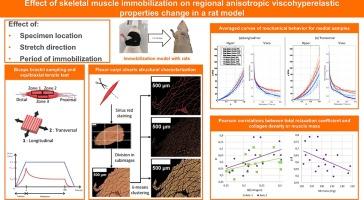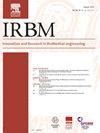骨骼肌固定对大鼠模型区域各向异性粘弹性特性变化的影响
IF 5.6
4区 医学
Q1 ENGINEERING, BIOMEDICAL
引用次数: 0
摘要
目的 研究短位固定骨骼肌随时间变化的被动机械特性。本研究旨在探索短位固定大鼠肱二头肌的三个不同区域(远端、近端和内侧)及其自由对侧。结果样品的切除区极大地影响了超弹性行为的参数,而固定则影响了粘弹性响应。根据尺侧屈肌组织学参数的测量结果,固定会导致收缩组织萎缩和结缔组织增厚。机械和结构特征之间存在相关性。通过组织学分析,可以量化固定骨骼肌中的纤维化,并与机械性能变化相关联。被固定的大鼠表现出骨骼肌明显萎缩、细胞外基质纤维化以及粘弹性参数变化的趋势。这项研究可能有助于未来对神经肌肉疾病(如导致肌肉固定的痉挛性肌病)的研究。本文章由计算机程序翻译,如有差异,请以英文原文为准。

Effect of Skeletal Muscle Immobilization on Regional Anisotropic Viscohyperelastic Properties Change in a Rat Model
Objectives
The passive mechanical properties of immobilized skeletal muscle in short position were investigated over time. The purpose of this study was to explore in three different zones (distal, proximal and medial) of the biceps brachii immobilized of rats in short position and its free contralateral.
Material and methods
In vitro equibiaxial relaxation tests were performed from samples harvested from immobilized skeletal muscles of rats during one or two weeks. Material parameters were identified by using a viscohyperelastic model described by an anisotropic strain energy function coupled with second order Maxwell's model.
Results
The excising zone of samples greatly influenced the parameters of the hyperelastic behavior while the immobilization had effects on the viscoelasticity response instead. Based on measurements of histological parameters from flexor carpi ulnaris muscles, the immobilization produced contractile tissue atrophy and connective tissue thickening. A correlation between mechanical and structural characteristics was given. The histological analysis permitted to quantify fibrosis in the immobilized skeletal muscle and to correlate with the mechanical behavior change.
Conclusion
The immobilization of skeletal muscles in short position is highly deleterious. Immobilized rats displayed marked atrophy of skeletal muscle, fibrosis of the extracellular matrix and a tendency to visco-hyperelastic parameter changes. This work has the potential to be useful for future research on neuromuscular diseases like spastic myopathy which leads to muscular immobilization.
求助全文
通过发布文献求助,成功后即可免费获取论文全文。
去求助
来源期刊

Irbm
ENGINEERING, BIOMEDICAL-
CiteScore
10.30
自引率
4.20%
发文量
81
审稿时长
57 days
期刊介绍:
IRBM is the journal of the AGBM (Alliance for engineering in Biology an Medicine / Alliance pour le génie biologique et médical) and the SFGBM (BioMedical Engineering French Society / Société française de génie biologique médical) and the AFIB (French Association of Biomedical Engineers / Association française des ingénieurs biomédicaux).
As a vehicle of information and knowledge in the field of biomedical technologies, IRBM is devoted to fundamental as well as clinical research. Biomedical engineering and use of new technologies are the cornerstones of IRBM, providing authors and users with the latest information. Its six issues per year propose reviews (state-of-the-art and current knowledge), original articles directed at fundamental research and articles focusing on biomedical engineering. All articles are submitted to peer reviewers acting as guarantors for IRBM''s scientific and medical content. The field covered by IRBM includes all the discipline of Biomedical engineering. Thereby, the type of papers published include those that cover the technological and methodological development in:
-Physiological and Biological Signal processing (EEG, MEG, ECG…)-
Medical Image processing-
Biomechanics-
Biomaterials-
Medical Physics-
Biophysics-
Physiological and Biological Sensors-
Information technologies in healthcare-
Disability research-
Computational physiology-
…
 求助内容:
求助内容: 应助结果提醒方式:
应助结果提醒方式:


